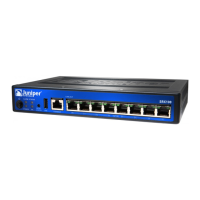4
contrast to the typical router active/standby resiliency protocols
such as Virtual Router Redundancy Protocol (VRRP), all dynamic
flow and session information is lost and must be reestablished in
the event of a failover. Some or all applications sessions will have
to restart depending on the convergence time of the links or nodes.
By maintaining state, not only is the session preserved, but security
is intact. In an unstable network, this active/active configuration
also mitigates link flapping affecting session performance.
Session-Based Forwarding Without the Performance Hit
In order to optimize the throughput and latency of the combined
router and firewall, Junos OS implements session-based
forwarding, an innovation that combines the session state
information of a traditional firewall and the next-hop forwarding
of a classic router into a single operation. With Junos OS, a
session that is permitted by the forwarding policy is added to
the forwarding table along with a pointer to the next-hop route.
Established sessions have a single table lookup to verify that the
session has been permitted and to find the next hop. This efficient
algorithm improves throughput and lowers latency for session
traffic when compared with a classic router that performs multiple
table lookups to verify session information and then to find a next-
hop route.
Figure 3 shows the session-based forwarding algorithm. When a
new session is established, the session-based architecture within
Junos OS verifies that the session is allowed by the forwarding
policies. If the session is allowed, Junos OS will look up the next-
hop route in the routing table. It then inserts the session and the
next-hop route into the session and forwarding table and forwards
the packet. Subsequent packets for the established session
require a single table lookup in the session and forwarding table,
and are forwarded to the egress interface.
Figure 3: Session-based forwarding algorithm
Security Policy Evaluation
and Next-Hop Lookup
Forwarding for
Permitted Trac
Ingress
Interface
Session Initial
Packet Processing
Table
Update
Disallowed by
Policy: Dropped
Egress
Interface
Session and
Forwarding Table
PSTN
Service Provider
SIP Soswitch
Service Provider
SIP Soswitch
PSTN
SRX210
J2350
POPPOPPOP
Clear channel T-1
Data (B8ZS)
Channelized T-1
Voice (AMI)
PBX
EX4200-24T
LARGE OFFICE
HEAD QUARTERS BRANCH BRANCH
J4350
EX4200 EX3200
Fax Fax
EX3200-24P
FIXED MOBILE SITE
(Mobile – 3G)
SMALL OFFICE
Cellular
Wireless
DSL
SRX210
Mobile
SRX210
INTERNET
J6350
Figure 4: The distributed enterprise

